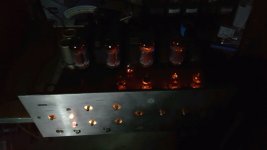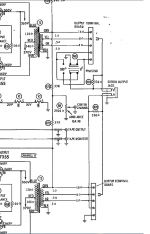Got home after work and set up the variac and powered up the amp with all the tubes loaded. Everything went well at 110 volts I was measuring .8 amps and all the tubes were glowing. Things are looking ok.
Hi Bob,
Excellent!
It pays to work carefully, just steady while thinking about what you are doing. So how does it sound?
-Chris
Excellent!
It pays to work carefully, just steady while thinking about what you are doing. So how does it sound?
-Chris
Channel B works but no channel A. Channel B sounds good. Tried Tuner and Aux input. Will try removing and reinserting preamp tubes for channel A. The input tubes were picked up used in unknown state of operation. I can also swap B tubes to A sockets?
Last edited:
if I have this straight...the stereo rev/nor switch, switches the input signals going into the preamp stage. When this switch is flipped channel B has sound. This tells me that the right and left input signals are reaching the preamp stage.
On initial test with music signal on both inputs there was some crackling sounds from channel A, they came and went several times and when the volume was turned all the way up, could barely hear the music. At this time only one speaker was hooked up on channel A. After hooking up a speaker on channel B, now speakers on A and B. Several power ups afterwards the crackling sounds did not occur and no low volume music comes from B channel.
Hi Bob,
Sorry for the late reply. I'm afraid I haven't been too useful to you lately. I still have things going on around here that make me too busy. I expect this to continue.
-Chris
Sorry for the late reply. I'm afraid I haven't been too useful to you lately. I still have things going on around here that make me too busy. I expect this to continue.
Yes. You have probably already swapped them.I can also swap B tubes to A sockets?
Normally, no. The "mode" switch is located between the preamplifier section and the output amplifier. So that means the signal is passed through the preamplifier just fine, and it is the output stage that isn't working properly.if I have this straight...the stereo rev/nor switch, switches the input signals going into the preamp stage.
You should never run a tube amplifier without a speaker or resistive load. Without any load, it's easy to cause high voltage breakdown of the insulation inside the transformer. For future reference, never even turn a tube amplifier on without the channel outputs having a load securely connected. The use of speakers during initial power up can give you early warning that something is amiss before all the smoke and sparks begin. Even table radio speakers will work for that.At this time only one speaker was hooked up on channel A. After hooking up a speaker on channel B, now speakers on A and B.
-Chris
Had a few minutes this morning swapped output tubes so I know all the outputs are good. Made measurements of the output sockets only noticeable difference is the cathode voltage on the working channel is 33V while the cathode voltage of the non working channel is 35V. Schematic shows 35V.
Also measured the secondary and primary windings on the output transformer on the non working channel. No opens and the ohm measurements were reasonable.
Also measured the secondary and primary windings on the output transformer on the non working channel. No opens and the ohm measurements were reasonable.
#1 signal killer is the tape monitor switch. Try jumping with clip on jumper....
Try that, along with de-soldering the line going back to the "tape out" and "tape in" just in case something's amiss back there. Additionally Check your coupling cap after the nor/rev switch.
Also another way to help check this is with your blend knob. If you blend over to mono and you get a pretty equal sound out of both speakers chances are the issue is between the nor/rev switch and the blend control. If you STILL don't get anything out of the A chan, I'd start looking in the tonstack onwards.
If its in the tonestack look at the packaged resistor/capacitor components, they'll go out potentially. I've had all these issues with the HK I'm currently dug into.
Just ohming out the tape monitor switch tests ok. Have discovered what seems to be an open area on the A channel volume pot. It tests good at low volume and high volume with an open area inbetween. Just using an ohm meter with the pot in circuit. Testing one channel against the other the other channel doesn't have this open area.
Can I hook the signal generator up and use oscope probe to follow signal through to the first driver tube? If the oscope probe is grounded to the chassis would it be okay to check the signal at the grid of the first driver tube.
Though I will set up and check voltages on the first driver tube.
Can I hook the signal generator up and use oscope probe to follow signal through to the first driver tube? If the oscope probe is grounded to the chassis would it be okay to check the signal at the grid of the first driver tube.
Though I will set up and check voltages on the first driver tube.
The input signal was confirmed to be present at the grid of the first driver tube. Also checked the voltages on that tube and the only value that was off a bit was the plate voltage should be around 175 volts and its measuring somewhere around 153 volts.
Hi Bob,
Don't worry about the plate voltage varying that much. I know it seems like a lot, but it really isn't. Turn it off and drain the B+. Measure the plate and cathode resistors in case they have drifted out of spec. If you need to replace a plate resistor, check the voltage rating of the replacement (yes, this does change from 50 V to 600 V and even higher. I used 3,500 V rated resistors on one of my amplifier rebuilds. I think the original carbon composition resistors are rated to 500 or 600 volts. You may have to go to a 1 or 2 watt resistor to get the rating high enough. Metal film, wire wound and metal oxide resistors are all available to the specs you are looking for.
Don't start desoldering stuff as a troubleshooting technique. Especially wires, try to leave them alone!
-Chris
Don't worry about the plate voltage varying that much. I know it seems like a lot, but it really isn't. Turn it off and drain the B+. Measure the plate and cathode resistors in case they have drifted out of spec. If you need to replace a plate resistor, check the voltage rating of the replacement (yes, this does change from 50 V to 600 V and even higher. I used 3,500 V rated resistors on one of my amplifier rebuilds. I think the original carbon composition resistors are rated to 500 or 600 volts. You may have to go to a 1 or 2 watt resistor to get the rating high enough. Metal film, wire wound and metal oxide resistors are all available to the specs you are looking for.
Don't start desoldering stuff as a troubleshooting technique. Especially wires, try to leave them alone!
-Chris
Watchout you'll have the whole amp disassembled soon
I had a HK A500 with a similar problem and I isolated the issue to the preamp section. As you can see it is a rather complicated preamp and to avoid dealing with that I turned the integrated amp into a regular amplifier. Now, I am not suggesting you do that without at least trying to fix your problem but as a stand alone amp it works greats and sounds fantastic! good luck.
I had a HK A500 with a similar problem and I isolated the issue to the preamp section. As you can see it is a rather complicated preamp and to avoid dealing with that I turned the integrated amp into a regular amplifier. Now, I am not suggesting you do that without at least trying to fix your problem but as a stand alone amp it works greats and sounds fantastic! good luck.
Hi Bob,
It looks pretty straight forward to me. Mind you, I've been looking at similar circuits my entire adult life.
-Chris
It looks pretty straight forward to me. Mind you, I've been looking at similar circuits my entire adult life.
-Chris
yep the wiring visually looks like it is all in place correctly. Was going to continue replacing coupling caps and realized that I had not received the 4pcs of .25uF caps I had ordered. I only received the 4pcs of .22uF confirmed by looking at the image posted earlier. So the .25's got replaced with the .22's. Any concerns with replacing the .25 caps with the .22? Went back and am probing why I had not received the .25's?
waiting for resistors to replace output cathode resistors. The carbon resist has splits in the body.
waiting for resistors to replace output cathode resistors. The carbon resist has splits in the body.
- Home
- Amplifiers
- Tubes / Valves
- Harmon Kardon A50K project

